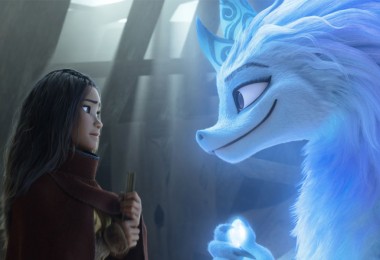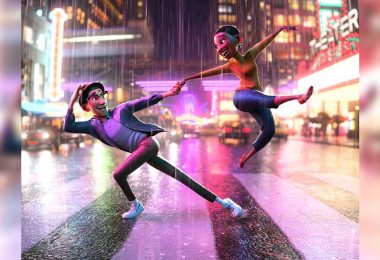By the D23 Team
Soar through the gorgeous world of Raya and the Last Dragon with the book The Art of Raya and the Last Dragon, featuring never-before-seen development art, character sketches, storyboards, and color scripts from the Walt Disney Animation Studios feature film. Get an inside look at how Disney Animation develops a film, from the initial idea to the big screen! If you’ve watched the movie, now streaming on Disney+, and want to keep exploring the world of Kumandra, we’ve got an exclusive look at some of the beautiful art featured in the book. Want to see more? You can add The Art of Raya and the Last Dragon by Kalikolehua Hurley & Osnat Shurer (Raya and the Last Dragon Producer) to your collection by purchasing it here.
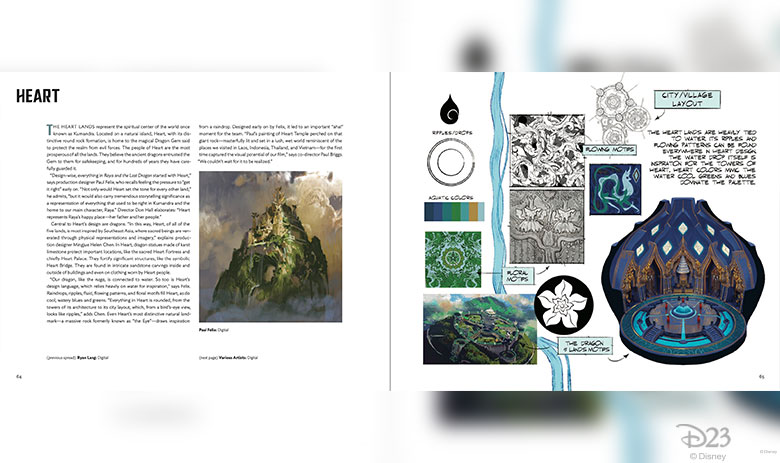
D23: The Official Disney Fan Club: Throughout The Art of Raya and the Last Dragon, you highlight the importance of trusting your collaboration partners. How easy or hard was it to continue to build that trust while working remotely on the film and the book during COVID-19?
Osnat Shurer (OS): When we first left the building, we thought it would be for about three weeks. That was over a year ago. There were technological hurdles to overcome, but with the genius team we have, that happened relatively quickly. Our bigger challenge was a social/creative one. Working together in person is in our Disney Animation DNA—spending time together in the room breaking and building story, having side conversations in the coffee line that resolve major design questions, popping down to editorial to review a quick take, etc. How to recreate that over Zoom? It took us a moment—we all had to learn to create clearer and stronger creative briefs, to delegate more fully to each other—basically to trust each other to create a singular movie from our 450 individual homes. And we did. I have never been prouder of a crew!!!
Kaliko Hurley (KH): Osnat is a dream Art of Book collaborator. She’s superbly talented and creative. As the producer of Raya and the Last Dragon, she also knew everything there was to know about the film, which allowed us to take a deep dive into the team’s incredible design process, even remotely!
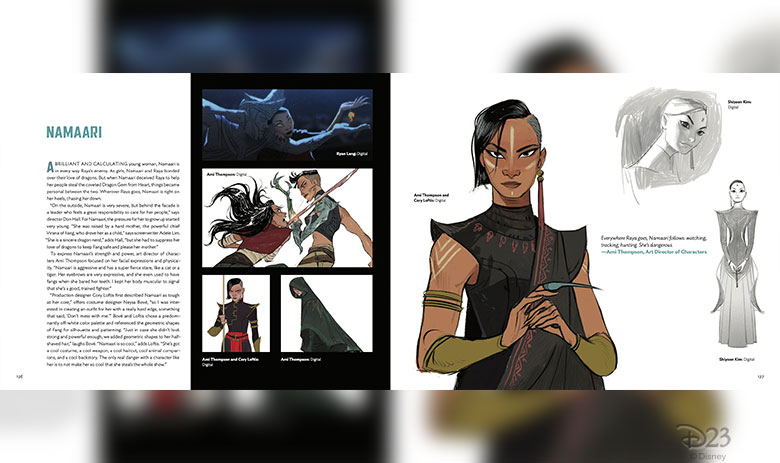
D23: Were there any specific pieces of art you built pages or sections around to ensure they were celebrated?
KH: Raya and the Last Dragon follows the journey of Raya across the five lands of Kumandra: Heart, Tail, Talon, Spine, and Fang. We loved the idea of matching the journey of the evolution of the art with Raya’s journey to allow readers interested in learning more about Kumandra’s design to follow along the film with book in hand.
OS: We build the entire book with the intention of celebrating the art and artists. Sections like “We are Kumandra” were created specifically to celebrate collaboration, both in the film, as when the characters finally come together around food, and in the collaborative process behind the scenes, including getting to work with our Southeast Asia Story Trust. In this book we also added sections on the uniquely story-driven cinematography, the incredible set extension work that made our world feel so epic, as well as some full spreads of gorgeous final frames from the movie.
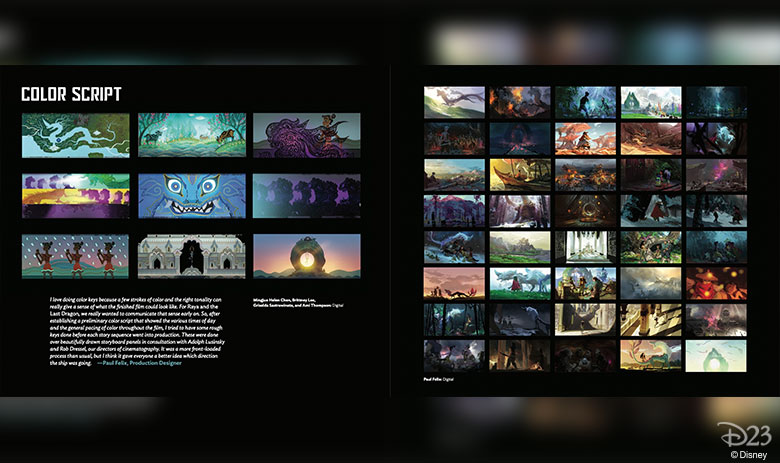
D23: What are your favorite pieces of art in the book and why?
OS: One favorite? Really? There are so many! OK, I’ll try. There’s the cover by Mingjue Helen Chen, the colors deeply inspired by a sunset she remembers in Luang Prabang in Laos during the research trip there. Then there’s the opening spread of Part 1 (pages 18/19), a moody painting of Raya leaning into Sisu dragon as they look over the island of Fang, by Paul Felix. I always felt this image captured the promise of the friendship between Raya and Sisu, which is at the heart of the film.
KH: Sisu’s design fills me with amazement. In fact, the first time I saw her realized in the film, I burst into tears. She’s just so powerful. So, I love to imagine how Raya must have felt in the moment Paul Felix painted of the two of them underwater gazing at each other in the opening Sisu spread. The prologue art pieces by Griselda Sastrawinata-Lemay, Mingjue Helen Chen, and Brittney Lee that find inspiration in shadow puppet traditions found in places like Indonesia are also among my favorites. They’re so beautiful and intricately detailed.

D23: The book showcases various iterations of the film characters. How do you and your teams know when you have landed on a character’s final look?
OS: It’s hard to know when you’ve landed on the final design. We’ve been known to think we’re there, and go forward into modeling and animation testing, only to realize that the character still needed more refinement as she moves, runs, fights, or emotes. Usually at this point, as happened with the character Raya, the art director of characters and the modeling lead will work together in the CG environment to refine the features.
There is a certain point you reach, though, where the characters on the screen take on a life of their own and begin to tell you what they need. I’ve always loved this moment on a movie!
KH: You can really feel that moment when a character comes together, when they’ve finally become who they’re meant to be. I feel lucky to have witnessed the evolution of so many characters from exploration to final look.

D23: It is clear when reading the book that a lot of thought went into designing the five lands of Kumandra. Were there any lands that proved to be more difficult to visually represent on screen than others?
OS: The unique qualities of each fantasy land, based on their environment, climate, character, and all inspired by Southeast Asian design principles, was quite a feat. Our production designer joked that we are designing five films, not one.
The land that was probably the last to really solidify in design was Fang. We had different story ideas early on about who they were, what drove the people of Fang. Once we landed on the man-made island, the love of hierarchy, formality, and the perception of strength, the design of Fang came together.
KH: The environments modeling team shared a lot about the complexity of Talon port, with its multi-leveled buildings, plentiful crowds characters, and vibrant props, all located on water. With that complexity, the team was able to create a set that felt so chaotic, exciting, and totally alive.

D23: The book mentions how you collaborated closely on the film and the book with the Southeast Asia Story Trust. How did this collaboration help you maintain cultural authenticity in both?
KH: Inclusion is key to our creative process at Disney Animation. We owe a great deal of gratitude to our formidable Southeast Asia Story Trust consulting team, including Dr. S. Steve Arounsack, Emiko Susilo, Dewa Berata, Dr. Juliana Wijaya, Jes Vu, Dr. Chen Chanratana, and Dr. Rebecca Hall, as well as many others who collaborated with us along our journey.




